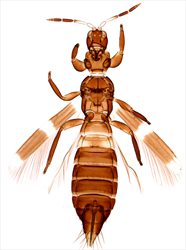
Female
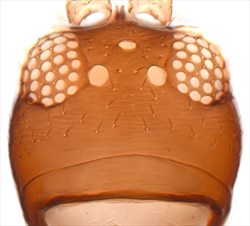
Head

Antenna (bright field)

Antenna (phase contrast)
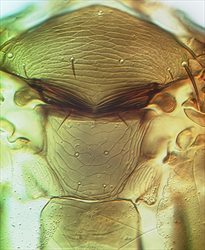
Meso & metanota
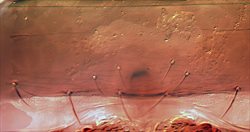
Female sternite VII
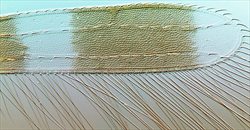
Tip of fore wing (phase contrast)

Fore wing
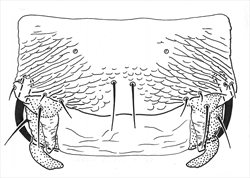
Male tergite IX
Both sexes with fore wings bearing two transverse dark bands, apical ring vein pale. Body and legs brown, antennal segment I pale, II–III largely yellow; abdominal segment X variable but often much paler than VIII–IX. Antennae 9-segmented, segment III with linear sensorium almost 0.5 as long as segment, IV with sensorium more than half length of segment and curved distally; segments V–IX forming a single unit with V considerably longer than VI–IX. Head and pronotum with no long setae; eyes prolonged on ventral surface, maxillary palps 3-segmented. Fore tarsus apically with stout recurved ventral hamus. Metanotal reticulation weak. Marginal setae on sternites arising at or close to margin; sternite VII paired accessory setae arising well in front of margin.
Male tergites IV and V with paired dorsal tubercles; setae at base of paired claspers on tergite IX shorter than clasper, with stout curved seta lateral to clasper.
Rather more than 100 species are placed in the genus Aeolothrips, mostly from the Palaearctic Region but with about 30 from the Nearctic including the western USA. A. ericae is a member of the Eurasian species-complex that includes A. intermedius and A. fasciatus Linnaeus. However, the males have a pair of very stout setae anterolateral to the bifurcate claspers on the ninth abdominal tergite. Females are readily distinguished from similar looking species in Britain by the pale colour of the basal antennal segments and the tenth abdominal segment that is often paler than segments VIII and IX.
Closely associated with the flowers of Erica and Calluna [Ericaceae], but also found in the flowers of various Fabaceae. This species is presumed to be a facultative predator, feeding on a mixed diet of pollen and the larvae of other thrips in the flowers where it breeds.
Described from British material (Bagnall, 1920), and widespread in Britain from Kent to Caithness, although not recorded from Ireland (Mound et al., 1976). This thrips occurs widely across Europe from Norway southwards. It has also been introduced into North America.
AEOLOTHRIPIDAE
Aeolothrips ericae Bagnall
Aeolothrips ericae Bagnall, 1920: 60
Aeolothrips nobilis ab. mulleri Priesner, 1920: 51
Aeolothrips nobilis Priesner, 1921: 21
Aeolothrips speciosus Melis, 1933: 169
Aeolothrips nobilis f. aterrima Hukkinen, 1935: 88
Aeolothrips vittatus var. albotarsata Keler, 1936: 87
Aeolothrips lucidus Oettingen, 1944: 40
Bagnall RS (1920) Preliminary notes and descriptions of some European species of Aeolothrips. Entomologist’s Monthly Magazine 56: 60–62.
Mound LA, Morison GD, Pitkin BR & Palmer JM (1976) Thysanoptera. Handbooks for the Identification of British Insects 1 (11): 1–79.